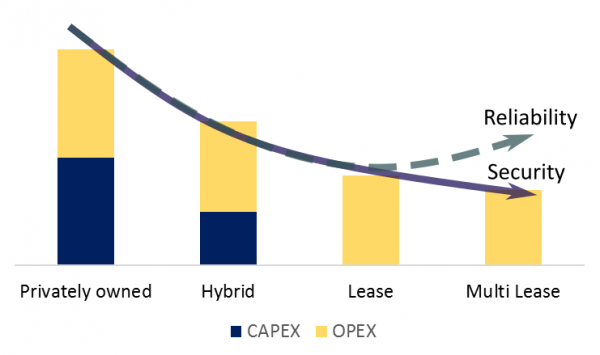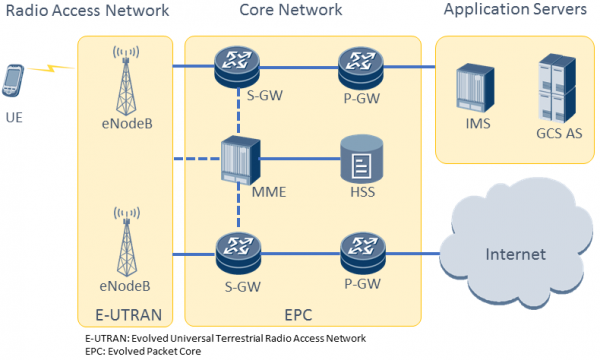
The case for private LTE networks
July 10, 2017
An increasing number of enterprises, especially in vertical industries such as utilities and transportation, consider replacing their mission critical or corporate communications infrastructure with an LTE network. This trend is driven by the need for more mobility, bandwidth, flexibility of coverage and multiple classes of services. In recent years, private LTE networks have been successfully deployed in many sectors including public protection and disaster relief (PPDR), energy, maritime and railway transportation.
LTE features
In contrast to previous mobile communications generations, LTE is an all-IP platform. As a result, it facilitates device compatibility and enables smooth integration of other IP-based applications. The recent LTE standards (3GPP Releases 12 and 13) have also inherent support for emerging Machine Type Communication (MTC), enabling easy roll-out of machine-to-machine communications (M2M) and Internet-of-Things (IoT) services on top of an LTE network. Powered by advanced modulation techniques and its wide frequency band, LTE exhibits:
- very high spectral efficiency and transmission speeds, with a maximum theoretical throughput of up to 300Mbit/s in the downlink and 150Mbit/s in the uplink, in an LTE-Advanced system
- high user density (up to 100,000 users per sq km)
- the ability to customise the quality of service attributes, including: bit rate, packet delay, priority and maximum packet loss
- flexibility of deployment in a wide range of licensed and unlicensed bands
- strong built-in security for authentication, message integrity and the radio interface using sophisticated cryptographic algorithms
- built-in self-organising and healing mechanisms.
While old professional radio systems used in mission critical networks are closed ecosystems and lack interoperability, LTE enjoys global standardisation. In addition, many mission critical applications can be added to LTE by means of software upgrades, including applications such as push-to-talk, push-to-video and group communications.
Deployment scenarios
One of the key decisions is the selection of a deployment strategy. Privately owned new-build, hybrid, leased and multi-leased networks are all possible (Exhibit 1). Each of these scenarios has advantages and disadvantages in terms of cost, reliability and security.
A leased network is more economic but provides less security and reliability. In a leased network all users, whether private or public, use the same access and core network. However, for mission critical applications, security can be partly enhanced by software upgrades in the base stations and on the user handsets. Moreover, a group communications service application server (GCS AS) may need to be installed by the mobile network operator (MNO) to enable group communications. If the infrastructure is sourced from multiple MNOs (multi-lease), further cost reductions can be achieved in addition to improved resilience and coverage.
Exhibit 1: Relative cost of deployment scenarios [Source: Network Strategies]

On the other hand, a privately-owned network option ensures the highest level of security since it provides full control over the network. Recently, the government of South Korea opted for a dedicated LTE network for public safety applications and for its entire railway network by 2025. Building a dedicated LTE network is the costliest option as it involves a considerable capital investment and a dedicated frequency band. A research report published by the Australian Productivity Commission found that deploying a dedicated public mobile broadband safety network is about 2.8 times more costly than using commercial LTE networks.
However, a hybrid LTE network can sometimes be a good compromise to meet all competing requirements. In such a scenario, only a part of the network is built and owned by the enterprise to provide services for the most critical applications while for the less critical applications network infrastructure is leased from another MNO. The private LTE owner may choose to build only a dedicated core network to implement its own data security policies while sharing the radio access network of a commercial operator. Dedicated core usually includes a home subscriber server (HSS), serving gateways (S-GW), a packet gateway (P-GW) and a GCS AS (Exhibit 2). Since most of the security functions are managed by the core network, this option is a balance between security and cost. Alternatively, a hybrid network can also involve building a dedicated radio access network with or without core functionalities.
Exhibit 2: Schematic of an LTE network [Source: Network Strategies]

Very often commercial mobile operators have no incentive to provide coverage in areas with low subscriber densities or special performance requirements, and hence a dedicated or a hybrid network may be the only options available. An example of such a scenario is an offshore oil and gas platform. Very recently, offshore LTE networks have been successfully deployed in the North Sea and the Gulf of Mexico.
Choosing the right deployment strategy depends on many factors and requires rigorous cost-benefit analysis considering all factors including: cost, demand, technology, coverage, security, reliability and deployment time.
